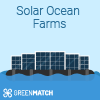- GreenMatch
- Solar Energy
- Solar Technology
Solar Technology - What's New in the Industry? (October 2025)

Solar Technology - What's New in the Solar Industry?

While solar power has a vast scope, the involved technologies are still at a young stage. That makes innovation and new ideas a constant companion of the solar power industry. Despite the pandemic, 663MW of solar generation capacity was installed in the UK by March 2021.
With a target of generating an additional 40GW of solar power by 2030, the growth aspects of the solar industry in the UK are strong. Here, we will explore some of the new solar technologies that can be turning points for solar energy generation.
Is Solar Technology Improving?
It goes without saying that solar technology will keep getting better with time. The last decade has seen huge advancements in developing new solar technology and the same is expected in the present one. In fact, the cost of solar power generation has fallen by 82% since 2010. As per projections, the market for solar power has a positive growth trajectory beyond 2021.
A significant amount of research and development is going on around the world to develop the overall quality and efficiency of solar panels. Other aspects of development include developing better storage solutions and driving down the costs of installing solar panels.
What Are the New Advancements in Solar Power?
Improved Solar Panel Efficiency
The low panel efficiency of solar panels of below 20% has always been a bottleneck for the technology. Actually, the efficiency of the panels is limited by the Shockley-Queisser limit. Apart from that, there are other factors like temperature, solar irradiance level, cell type, and cell interconnections that affect the efficiency levels.
The good news is, 2021 has seen some of the most efficient types of solar panels being released in the market. All the top ten panels in the market have an efficiency of over 21% and the highest levels are above 22%, including bifacial solar panels. With higher efficiency, these panels will also require less area for installation and are great for small rooftops.
These next-generation panels use highly pure N-type cells and have a low degradation rate of around 0.3% power loss per year. This allows them to function at a rate of 90% or more even after 25 years of use. With a higher power generation rate, these panels will be able to pay back the upfront costs much earlier, ensuring a better return on the investment.
In addition, an Oxford-based technology firm has developed a new solar panel technology that can raise solar power efficiency levels close to 28%. This involves coating the panels with a thin layer of a special crystal called perovskite. The commercial manufacturing of these panels may begin by the end of the year.
Advancements in Thin-Film Solar Cell Technology
Traditionally, thin-film solar panels have been less efficient than standard panels. But the new developments in solar panel technology are changing that. While the most common material used in thin-film panels is amorphous silicon, other materials like Cadmium Telluride, Copper Indium Gallium Selenide, and Gallium Arsenide are now being used to develop more efficient thin-film panels.
This has resulted in the development of a flexible and less expensive solar fabric that can be used over any structural shape. These cells can be folded and even rolled to make them effective in a wide range of scenarios. Also, the fabric is long-lasting and can respond well to temperature variations. In the future, this fabric can be used on your clothing, for delivering power on the go.
Beyond that, these cells are effective even in low light conditions. The technology is easy to install, and not only effective for large commercial buildings, but also for private residences and vehicles. Another advantage of thin-film cells is their manufacturing involves much lower levels of emission.
Crystalline silicon panels have dominated the solar market for years. But the past few years have seen a resurgence in the thin-film markets with multiple producers setting up new manufacturing plants across the world.
Structural Integration of Photovoltaics
Integrating photovoltaics within the structure of a building is a popular concept involving Solar Electric Architecture. This technology is growing at a fast rate in Europe, the U.S, and Japan. The market is expected to reach $86.7 billion by 2030.
Apart from effectively harnessing the power of solar energy, Building Integrated Photovoltaics (BIPV) also adds to the aesthetic appeal of a structure. Instead of being mounted on the top surface, these glass panels are an integral part of the building architecture.
The PV glass or solar glass is made from transparent photovoltaic cells that are sandwiched between two toughened glass layers. The transparency and colour of the glass can also be selected based on the requirements and light conditions. A special form of organic polymer PV glass that can operate in low light conditions is the latest development by a UK-based firm.
Having a BIPV system not only reduces the saving of construction materials but also reduces electricity costs. Other benefits include reduced maintenance costs, thermal optimization, and reduced emissions.
Capturing Solar Energy at Night

If you think solar energy is only generated during the daytime, think again. The latest solar technology has led to the development of anti-solar panels that can generate power during the night. These specially designed panels capture the heat that is radiated from the earth in the form of infrared radiation during the night.
Obviously, the process will generate less amount of power when compared to day-time generation figures. But even a 25% capacity of any traditional solar power system can lead to a significant rise in the overall power generation. Besides, these figures will increase as the technology develops in the coming years.
The inability to generate power at night is considered a major drawback of solar energy. With this technology, solar energy can be more reliable as well as a practical option in various industries. While widespread use of the technology will take some time, it will have a significant impact on the future of solar energy.
New Solar Technology
Solar Ocean Farms

Recently, Singapore has completed the construction of a floating solar farm with a peak capacity of 5MW. Ocean-based solar energy can be a great booster for the solar power industry. Marine installations are a perfect solution for cities facing land scarcity. Such installations allow the use of under-utilised stretches of the ocean and the seawater acts as an effective coolant for the panels as well.
Photovoltaic solar noise barriers (PVNB)

Around 3,000 miles of traffic noise barrier has been built across 48 states in the US to reduce traffic noise. These barriers have been integrated with PV modules that generate electricity from solar energy. As per projections, these noise barriers can generate 400 GWh in a year.
Agrivoltaics

This technology involves installing solar panels over agricultural lands that can make the farms self-sustaining. Also, the shade from the panels can help in the growth of the crops and reduce water consumption by minimizing evaporation. Currently, some of these projects are underway in Europe, Japan, and South Korea.
What is the best solar technology?
Even the latest solar technology may not be the best choice if it doesn’t match the user’s requirement. The best solar panels are the ones that deliver an optimised power output within your budget.
For example, monocrystalline solar panels have the best efficiency, but they are more expensive. On the other hand, polycrystalline panels are cheaper but come with lower efficiency levels. If you want the lowest price along with ease of installation and low maintenance, thin-film panels are the best choice.
Overall, the solar technologies emerging in 2021 have enhanced the versatility of the new solar power systems. With more promising tech on the horizon, the future of solar power looks exciting.

Rich Murphy is a survival and outdoor writer at Persurvive.com. He feels we all should be ready for anything. Whether it’s a personal or natural disaster, his goal is all about educating people how to survive.
We strive to connect our customers with the right product and supplier. Would you like to be part of GreenMatch?

Stay up to date with energy saving tips and grant alerts
Receive offers, marketing and promotions via email from Leads.io about GreenMatch and our brands/partners to help you save.
Thank you for subscribing to our newsletter!
Your email has been successfully added to our list. We look forward to sharing our latest updates with you soon!
